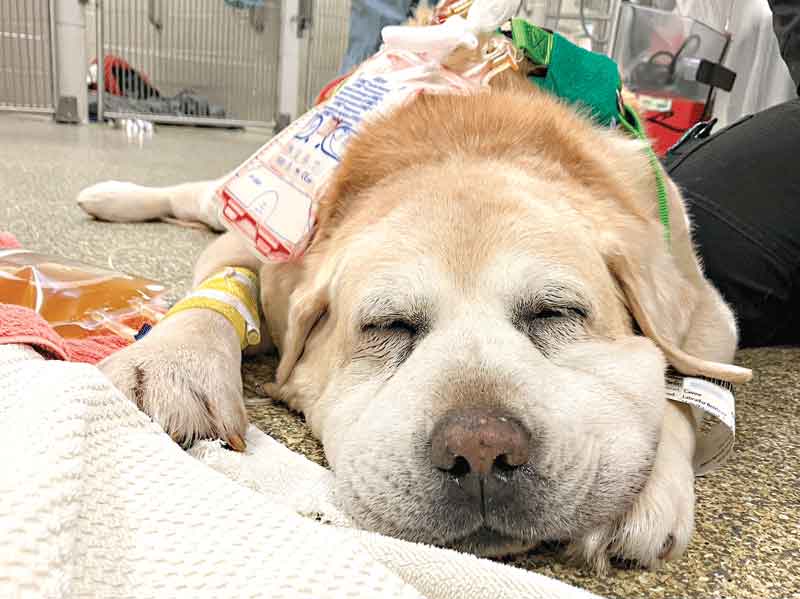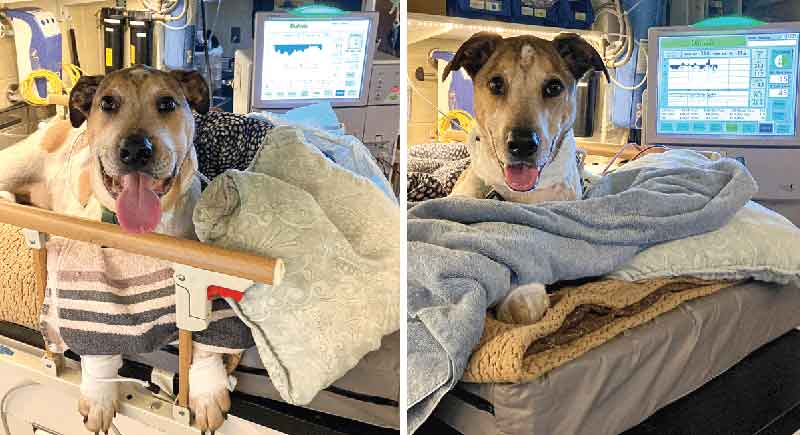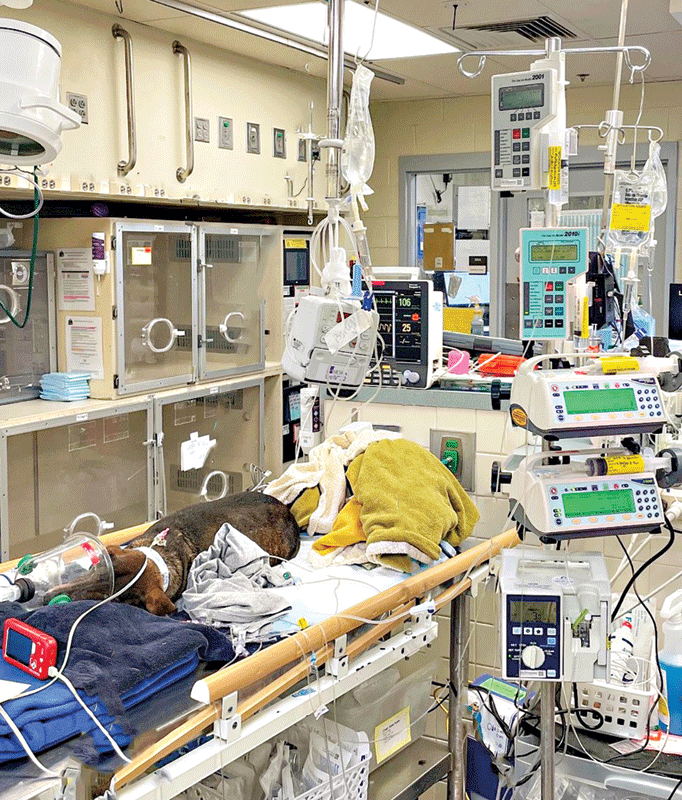
Photos courtesy Emmanuelle Butty, Alexandra Pfaff
Intravenous fluids are commonly used to stabilize hospitalized patients, especially those that have experienced significant trauma. When used properly, they replace fluids and electrolytes and help patients heal. Otherwise, if not properly monitored over days, the use of IV fluids can result in dangerous, even deadly, fluid overload if used in excess, or delayed stabilization and rehydration if too little is used.
At the Cummings Veterinary School at Tufts University in North Grafton, Massachusetts, Emmanuelle Butty, med.vet, DACVIM (SAIM), clinical assistant professor, Small Animal Internal Medicine; and Alexandra Pfaff, med.vet, DACVECC, clinical assistant professor, department of Clinical Services, have launched an initiative encouraging animal hospitals to rethink the use of IV fluids in hospitalized patients.
“In human medicine, extensive research into the effects of intravenous fluids only started around 10 years ago,” says Dr. Pfaff. “But there are many publications over the past decade that have looked at the effects of giving too much or too little fluids, and how different regimens affect patients. There is much research to do, so many things we could look at to improve patient care.”
Toward that goal, Drs. Butty and Pfaff established the Tufts Fluid Stewardship Team, a multidisciplinary group that includes critical care, internal medicine, anesthesia, pharmacology, and nursing. “Nurses are the ones who actually administer fluids and we felt strongly that we wanted their input and buy-in,” Pfaff says.
The team meets monthly to discuss issues related to the use of intravenous fluids and has conducted a large retrospective study to analyze old patient records to determine where potential problems exist, and what can be learned from previous patients, Pfaff says.
“Based on what we have discovered there, we’ve been trying to start some educational efforts, including continuing education for interns, residents and students,” Pfaff says. “We’ve restructured fluid lectures and have done talks to raise awareness and inform people that this is what we’re working on. We have also added some small standards of practice, including how we dilute medications so we can decrease the amount of fluid that we’re giving patients and reduce the patient’s sodium loads.”

The role of IV fluids
IV fluids can play a critical role in patient recovery, replacing fluids lost because of bleeding, vomiting, diarrhea, and a general inability to eat and drink. “Fluids are commonly delivered intravenously to replenish the vascular system and tissue perfusion,” says Butty. “The patient may be in shock and need a lot of fluids to restore good perfusion of all the organs. Fluids are also needed to correct dehydration.”
If the use of intravenous fluids continues over a period of days without close monitoring, fluid overload may result. “We have to make sure that we give the body what it needs to restore all functions, but we don’t want to overdo it,” Butty explains. “A healthy patient will require a lot of fluids before complications occur because it can readjust rapidly to excrete excess fluids. Problems mainly occur in very critical patients with severe diseases and perhaps multiple comorbidities.”
When an ailing patient receives an excess of fluids, it can result in significant edema in major organs, which can affect proper function, Butty says. An edematous gastrointestinal system, for example, may have issues with motility, while edema in the brain can result in swelling and impaired cognition.
Fluid overload can also affect the heart and lungs, but it is the kidneys–tasked with trying to get rid of the excess fluid–that most often take the brunt of it, resulting in swelling and excessive pressure.
“All of that will further reduce the ability of the kidneys to handle all of the fluid and can even lead to complete renal failure. It’s really a vicious circle,” Pfaff says.
Prescription process

The clinical signs of fluid overload are, unfortunately, only evident when the fluid burden is marked to severe, and include a weight gain of 10 percent or more, edema affecting the face and body, and changes in respiration, often the result of pulmonary edema.
One goal of the Tufts Fluid Stewardship Team is to encourage veterinarians to start looking at intravenous fluids as drugs and think more about the prescription process. “If we really start looking at them as drugs, we would start thinking more thoroughly about dosing and how much fluid is really appropriate for the patient,” Pfaff says. “What type of fluid is appropriate? Does the patient really need this drug? That is fluid stewardship in the early stages. How much and what kind of fluid a patient really needs is something I, myself, have just started to think more about in the past couple of years.”
Treating fluid overload can be tricky. Pfaff recalls a large breed dog that came in with sepsis and was treated with IV fluids over several days, resulting in obvious edema and worsening kidney function. “After two days, we decided to try to remove some of the extra fluids through dialysis to see if that would help the patient feel better,” Pfaff explains.
“We did two sessions, and in addition to the patient looking better because the edema was improving, we could see that its kidney function was improving. That was memorable for Dr. Butty and me because the fact that fluid overload decreases kidney function is something that we know from human medicine, but have never really been able to prove in animals. In this dog, it was obvious that removing a little bit of fluid didn’t just help reduce visible edema, but actually helped kidney function as well.”
Issues with dosing
Veterinary students are well educated regarding the need and use of intravenous fluids, yet Pfaff reports many practicing veterinarians still feel a bit uncomfortable when it comes to dosing, length of use, and more. There is no real gold standard of use, she notes, though the American Animal Hospital Association (AHAA) published fluid guidelines for dogs and cats in 2013.1
“A 2018 report2 found a pretty large number of veterinarians who admitted they struggled with knowing how much to use and what to add to the fluids, and I think that highlights there is definitely an educational gap that is worth closing,” says Pfaff.
Pfaff encourages the use of the so-called R.O.S.E. model (resuscitation, optimization, stabilization, evacuation), which divides fluid administration into different phases of disease or illness and highlights how fluids affect patient change.
“This encourages the liberal use of fluids when a patient comes in critically ill because we need that in order to stabilize the patient, improve oxygen delivery to the tissues and correct dehydration,” Pfaff explains. “But after 24 hours of hospitalization, we need to start being more conservative regarding the use of fluids. If the patient is not stable by then, we must start thinking about other options, such as the use of blood pressure-elevating medication or blood transfusions.”
Butty encourages practitioners to remember that IV fluids are drugs that must be individualized based on the patient’s medical assessment, comorbidities, and phase of hospitalization. “Reassessment after a couple of hours will help determine whether you have reached your goal of hydration and stabilization,” Butt adds. “Over a couple of hours, you’re probably not going to make a mistake, as opposed to a couple of days without any reassessment, when things can go wrong rapidly.”
Pfaff agrees and recommends practitioners begin fluid use by determining what phase of disease the patient is in, and how fluid therapy will help. “Can I be liberal, or am I actually further into the hospitalization and have to consciously try to decrease fluid intake?” Pfaff posits. “That’s one of the things we’ve been trying to get across. The other is assessing fluid plans frequently. If you do that every few hours, it’s much harder to cause harm.” l
Don Vaughan is an award-winning writer who frequently writes about veterinary-related topics.
References
- https://www.aaha.org/aaha-guidelines/fluid-therapy/fluid-therapy-guidelines/
- https://avmajournals.avma.org/view/journals/javma/252/5/javma.252.5.553.xml. Citation: An online survey of small animal veterinarians regarding current fluid therapy practices in dogs and cats.Kate Hopper BVSc, PhD, Alejandro Garcia Rojas DVM, and Linda Barter BVSc, PhD. DOI: https://doi.org/10.2460/javma.252.5.553 Volume/Issue:Volume 252: Issue 5 Online Publication Date:01 Mar 2018.
